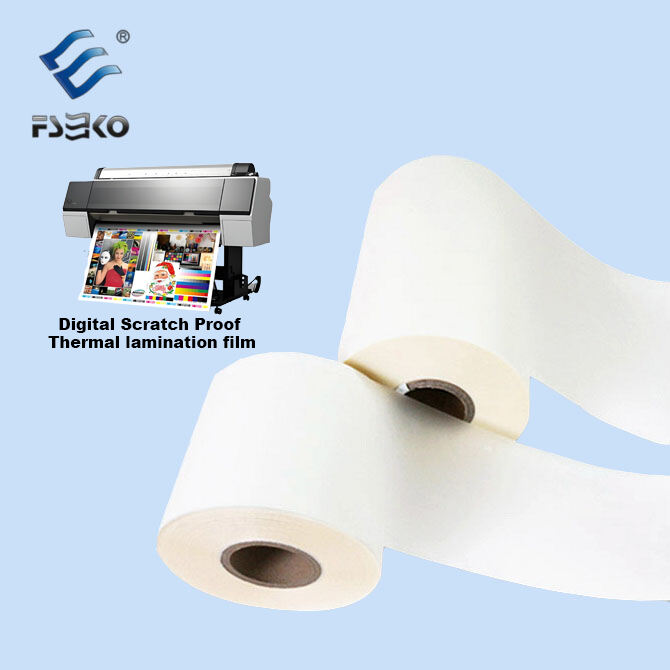How Digital Scratch Proof Film Protects Surfaces
The Rising Demand for Surface Protection Solutions
Industries across the board are under serious pressure these days to keep their products looking good as new. Take a look at what's happening in car manufacturing, consumer electronics, and premium packaging markets - according to the latest numbers from the 2024 Industrial Surface Protection Report, customers get way more upset when they spot surface damage. The stats actually show around four and a half times more complaints when products start showing signs of wear and tear. No wonder companies are turning to digital scratch resistant films now. These advanced coatings cut down on maintenance expenses by nearly three quarters compared to old school paint jobs, especially where things get handled constantly like store window displays or smartphone touchscreens that take a beating every day.
Core Principle: How Digital Scratch Proof Film Prevents Damage
Scratch-resistant films combine:
- Nanoscale-hardened coatings (silica or acrylic-based) that absorb friction
- Cross-linked polymer structures to prevent cracking under stress
- UV inhibitors to block yellowing from sunlight exposure
These layers create a "sacrificial shield," redirecting abrasion energy away from the protected surface. For example, films with self-repairing polymer matrices can fill minor scratches via heat activation, maintaining optical clarity for over 5 years in outdoor signage.
Performance in Automotive and Consumer Electronics Applications
Automotive testing shows that scratch resistant films can survive over 20,000 car washes without harming the paint underneath, which matters a lot when it comes to keeping that sweet resale value intact. When applied to phones and tablets, they keep touchscreen responsiveness at around 98% while stopping most of those tiny scratches caused by keys or gritty sand getting into pockets. Some independent labs have tested these films too, finding they still let through about 95% light after three full years of regular handling. That actually beats what tempered glass protection offers in many cases, making them pretty impressive for everyday device owners looking to protect their screens without sacrificing usability.
The Science of Scratch Resistance: Materials and Technology
Polymer Engineering Behind Scratch Resistant Films
Today's scratch resistant films are made possible through some pretty cool polymer engineering tricks that help surfaces stand up against everyday wear and tear. The secret lies in those cross linked molecular chains that basically act like a microscopic armor layer. A recent study back in 2024 showed these special designs can actually boost scratch resistance by around 60 percent when compared to regular coatings that don't have this structure. Most manufacturers play around with how dense the layers are, usually somewhere between 0.8 and 1.2 grams per cubic centimeter, trying to get just right mix of flexibility and hardness. Looking at data from the latest Polymer Engineering Report, it turns out plasma enhanced deposition methods let these films stay super clear (like 99.4% optical clarity) even as they hit those tough 3H pencil hardness standards. Pretty impressive stuff for something so thin!
Role of Thermoplastic Polyurethane (TPU) in Durability
Digital scratch resistant films have been transformed by Thermoplastic Polyurethane, or TPU for short. What makes this material special is its unique segmented copolymer structure. The hard parts give it real stiffness, typically around Shore hardness levels between 85A and 95A. Meanwhile, those softer ether or ester components let the material stretch quite a bit, somewhere in the range of 400 to 600 percent elongation. Recent tests back in 2023 found that TPU based films can actually survive more than fifty thousand rubs against steel wool of Grade 0000 quality. That's pretty impressive when compared to regular coatings which don't last nearly as long, maybe only about one fourth the durability. And here's another thing about TPU that sets it apart from harder materials: its special hydrogen bonded network actually soaks up impact energy. We're talking about something like 0.35 to 0.55 joules per square millimeter being absorbed during impacts. This property helps stop cracks from spreading all over surfaces after they get hit.
TPU vs. PVC: Why TPU Excels in Digital Scratch Proof Film
| Property | TPU Film | PVC Film |
|---|---|---|
| Elastic Recovery | 98% after deformation | 72% after deformation |
| UV Resistance | 10,000+ hours @ 0.8 W/m² | 3,000 hours @ 0.8 W/m² |
| Clarity Retention | >95% after 5 years | 78% after 2 years |
| Thermal Stability | -40°C to 120°C | -10°C to 70°C |
TPU maintains edge clarity (<0.5 μm light distortion) even after thermal cycling, making it essential for curved displays and automotive wraps. PVC degrades 3x faster under UV exposure, developing yellow tints (ΔE >5) within 18 months.
Self-Healing Technology and Long-Term Film Performance
How Self-Healing PPF Works: Heat, Pressure, and UV Activation
Scratch resistant digital film works thanks to built-in healing properties where special plastics fix small nicks on their own. When warmed by something as simple as sunlight between 40 and 60 degrees Celsius or even just room heating, the top layer becomes softer so those plastic molecules can move around and patch up tiny scratches pretty quickly. Exposure to ultraviolet light actually speeds things up because certain ingredients in the material react to the UV rays. According to lab testing, most of these microscratches that are no deeper than 20 micrometers get completely repaired automatically without anyone needing to touch them at all.
Real-World Durability and Lifespan in Outdoor and Industrial Use
Tests done in real world conditions show that self healing films can keep around 85 percent optical clarity even after sitting outside for 5 to 7 years. These materials beat regular films when it comes to handling UV damage, performing about 2.3 times better overall. Car manufacturers have tested them in hot desert environments where temperatures average about 45 degrees Celsius. The results? Pretty good scratch recovery most of the time. But there is one catch worth mentioning: if left exposed for longer than eight years, the healing properties start to decline by roughly 15 to 20 percent. Looking at industrial settings, companies report needing to replace surfaces on their equipment about 62 percent less often each year since switching to these advanced films, based on recent abrasion protection reports from 2023.
Limitations of Self-Repair Under Extreme Conditions
These films work pretty well for regular day to day damage but they struggle when temps drop below minus 20 degrees Celsius or climb over 80 degrees. At those extremes, the polymers inside basically stop moving around, which limits the self repair process to only about half of what it normally could achieve. Big scratches deeper than 100 microns or exposure to harsh industrial chemicals like acetone will definitely go beyond what the material can fix on its own. Most companies actually suggest pairing these protective coatings with regular checkups from professionals if they're going to be used in really tough conditions. This extra care helps stretch out the lifespan of the product somewhere between 8 and 12 years depending on how hard it gets used.
Cost-Effectiveness and Return on Investment
Reducing Maintenance and Replacement Costs with Protective Films
Scratch resistant protective films can really cut down on long term costs because they stop surfaces from wearing out so fast across different industries. Car makers who apply these protective layers see around two thirds fewer repair requests for damaged paint each year than those without protection according to Ponemon's research from last year. For gadgets too, companies making electronics find their products last longer when covered with scratch proof coatings. Components need replacing about 40 percent less often since minor scratches don't accumulate over time. Factory floor managers tell us they typically save roughly eighteen thousand dollars every year just by not having to repaint or refinish machines repeatedly. These films hold up pretty well actually lasting between five to seven years without needing attention. That means businesses spend significantly less money overall on maintenance especially when installed outdoors where weather takes its toll.
ROI in Luxury Packaging and High-Value Surface Applications
Luxury brands are finding that digital scratch proof film pays off in two big ways: keeping things looking new and protecting their valuable brand image. Recent studies from 2024 on expensive packaging show something interesting. Products wrapped in scratch resistant films tend to sell for about 25-30% more when resold later, and customers return them roughly a third less often than unprotected items. Looking at gadgets, applying these protective films to touchscreens and shiny metal surfaces has cut down warranty claims by around 18-20%, according to industry reports. Plus, devices last longer between replacements, sometimes adding 2 or even 3 extra years of use. Outdoor businesses using digital signs have also benefited. The coating saves money on recoating costs, cutting expenses by about $120 per square meter over ten years. This means most businesses see their investment back within just 16-18 months, especially where lots of people pass by daily.
Key Industry Applications of Digital Scratch Proof Film
Automotive: Preserving Paint and Aesthetic Value
High-end automotive finishes require protection against road debris and incidental scratches. Digital scratch proof film shields paintwork while maintaining gloss levels comparable to untreated surfaces (85% reflectance retention per 2023 surface protection studies). Dealerships report 65% fewer corrective polishing interventions on vehicles equipped with these films during pre-delivery inspections.
Electronics and Touchscreens: Clarity Meets Protection
The 2.5x increase in foldable device adoption (2024) drives demand for films that protect OLED screens without compromising touch sensitivity. Industry studies confirm 99.8% light transmission rates in premium-grade digital scratch proof films, enabling seamless stylus input and anti-fingerprint performance even after 50,000 swipe cycles.
Luxury Packaging and Outdoor Signage: Safety and Brand Enhancement
Around 38 percent of top-end cosmetic packaging these days comes with scratch resistant film coatings, which can keep displays looking good for three to five years longer in stores. When it comes to outdoor use, there are special UV stable versions available too. These maintain their colors pretty well actually, holding onto about 95% of original vibrancy even after sitting out in the sun for two whole years according to that latest Material Innovation Report from 2024. And let's not forget about those self healing films either. The newer generation ones cut down on replacement expenses quite a bit, saving around twelve dollars per square meter for busy areas where signs get lots of wear and tear.
FAQ Section
What is digital scratch proof film?
Digital scratch proof film is a type of protective coating that prevents surface damage by absorbing friction and reducing abrasion. It often includes nanoscale-hardened coatings, cross-linked polymer structures, and UV inhibitors.
How long do digital scratch proof films last?
These films typically last between five to seven years, depending on environmental conditions and usage. Some films also feature self-healing properties that can repair minor scratches, extending their lifespan.
What are the advantages of using TPU in digital scratch proof film?
Thermoplastic Polyurethane (TPU) offers superior flexibility, UV resistance, and clarity retention compared to PVC. Its unique copolymer structure allows for excellent impact absorption and durability.
Can digital scratch proof films be used on automotive surfaces?
Yes, they are commonly used on automotive surfaces to protect paint and maintain aesthetic value. They are effective against road debris and minor scratches, preserving the car's resale value.


